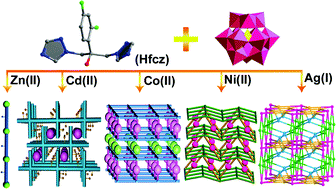Five POM-based hybrid materials have been designed and synthesized based on different metal ions under hydrothermal conditions, namely, [Zn(Hfcz)(H2O)3](H3fcz)(SiMo12O40)·3H2O (1), [Cd2(Hfcz)6(H2O)2](SiMo12O40)·H2O (2), [Co2(Hfcz)2(SiW12O40)](H3fcz)2(SiW12O40)·10H2O (3), [Ni2(Hfcz)4(H2O)2](SiW12O40)·5H2O (4) and [Ag4(Hfcz)2(SiMo12O40)] (5), where Hfcz is fluconazole [2-(2,4-difluorophenyl)-1,3-di(1H-1,2,4-triazol-1-yl)propan-2-ol]. Their crystal structures have been determined by X-ray diffraction, elemental analyses, IR spectra, and thermogravimetric analyses (TGA). There are 1D mono and double chain-like metal–organic units in compounds 1 and 2, respectively. Polyoxometalates and metal–organic units co-crystallize through hydrogen bonds. In compound 3, metal–organic sheets are pillared by one kind of polyanion through covalent connections to generate a sandwich double-sheet. The other kind of polyanion acts as a counter-ion and lies in two adjacent sandwich double-sheets through non-covalent interactions. Polyanions covalently link metal–organic sheets to extend to an unusual 3D 5-connected framework with the (44·66) topology in 4. In compound 5, polyanions link metal–organic chains to form a sheet through covalent connections. It is interesting that compound 5 shows an intricate (4,5,10)-connected framework with (44·62)4(48·62)2(414·619·812) topology based on two kinds of Ag cations as four-connected and five-connected nodes, and polyanions as ten-connected nodes, when Ag⋯O interactions are considered. It represents the highest connected network topology presently known for polyoxometalate systems. The structural differences among 1–5 indicate the importance of different metal–organic units, coordination modes of polyanions for framework formation, and the interactions between polyanions and metal–organic units. In addition, the luminescent properties of compounds 1, 2 and 5, and electrochemical behaviours of compounds 1–5 have been investigated.


 Please wait while we load your content...
Please wait while we load your content...